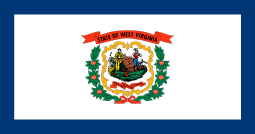3rd West Virginia Volunteer Cavalry Regiment
The 3rd West Virginia Volunteer Cavalry Regiment was a cavalry regiment that served in the Union Army during the American Civil War. In 1864, the regiment had an important part in the Battle of Moorefield, where a surprise attack led by General William W. Averell routed Confederate cavalry. The regiment also fought in the latter part of General Philip H. Sheridan's Valley Campaign, and was part of Capehart's Fighting Brigade in General George Armstrong Custer's Third Division. It was present at General Robert E. Lee's surrender of the Army of Northern Virginia at the Battle of Appomattox Court House.
| 3rd West Virginia Volunteer Cavalry Regiment | |
|---|---|
 Flag of West Virginia | |
| Active | December 1861 to June 23, 1865 |
| Country | United States |
| Allegiance | Union |
| Branch | Cavalry |
| Engagements | Battle of Cross Keys Battle of Second Bull Run Battle of Brandy Station Second Battle of Winchester Battle of Upperville Battle of Gettysburg Battle of Williamsport Battle of Bristoe Station Battle of Lynchburg Battle of Kernstown II Battle of Moorefield Battle of Opequon Battle of Fisher's Hill Battle of Waynesboro, Virginia Battle of Dinwiddie Court House Battle of Five Forks Battle of Sailor's Creek Battle of Namozine Church Battle of Sailor's Creek Battle of Appomattox Station Battle of Appomattox Court House |
| Commanders | |
| Lt. Colonel | David H. Strother 1862–1864 |
| Colonel | John L. McGee 1864–65 |
.jpg)
Organization
The 3rd West Virginia Cavalry was organized in western Virginia in December, 1861, with the first company of the regiment organized and recruited in Morgantown. It was the first cavalry regiment raised by West Virginia under the Union government in Wheeling.
Early action
Under Captain J.L. McGee, the regiment first reported to General B.F. Kelley at Grafton, where it was ordered to New Creek (Keyser), then on to take part in General Kelley's advance on Romney, where it charged Confederate breastworks. This charge was delivered with fine spirit and most satisfactory results, with the whole of the enemy's artillery, stores and flags being taken without casualties.
This advance was soon followed by the surprise of the Rebels at Blues Gap; resulting in the capture of a number of rebel prisoners, three pieces of artillery and the entire camp's supplies and munitions, driving them to the eastern slope of the Alleghenies and transferring the field of active operations to the Valley of Virginia. Captain McGee was promoted to Major of the 3rd West Virginia Cavalry on October 2, 1861.
In 1862, Company C, under Captain Conger, frequently engaged Confederate troops while in pursuit of “Stonewall” Jackson during his retreat up the Shenandoah Valley.
War's end
On April 2, 1864 at Ford's Station, under Lieutenant-Colonel John S. Witcher, the 3rd Cavalry charged and drove back a brigade of rebel cavalry, killing Confederate General Pegram. The regiment continued its duty, participating in the engagements at Appmattox Station and Court House, consequently present during Robert E. Lee's surrender on April 9.
The regiment participated in the Grand Review of the Armies and was mustered out on June 23, 1865.
Casualties
The 3rd West Virginia Cavalry suffered 6 officers and 40 enlisted men killed or mortally wounded in battle and 136 enlisted men dead from disease for a total of 182 fatalities.
Commanders
References
- The Civil War Archive
- Lang, Theodore F. (1895). Loyal West Virginia from 1861 to 1865: With an Introductory Chapter on the Status of Virginia for Thirty Years Prior to the War. Deutsch publishing Company. pp. 197–.

See also
- West Virginia Units in the Civil War
- West Virginia in the Civil War
- Sgt of Co D 3rd W V Cavalry